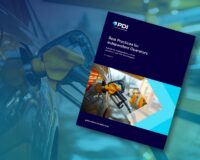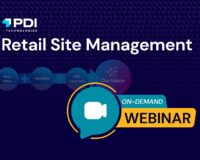
For today’s companies, having a positive brand image is almost as important as making a high-quality product. Consumers are more attuned to reviews than ever before and want to support brands that align with their values, especially when it comes to social responsibility.
According to the 2022 Business of Sustainability Index, 70% of Americans say that climate events from the past year have made them more likely to purchase environmentally friendly products. Having a good sustainability strategy presents an opportunity for your company to stand apart from your competitors and appeal to the majority of consumers who are concerned about climate change. A defined strategy may also position your company favorably with corporate and public sector customers that are prioritizing emission reduction across their supply chains.
According to the EPA, the transportation sector is now the leading source of greenhouse gas (GHG) emissions in the U.S., surpassing electric power generation. Figuring out how to reduce the tailpipe gases of almost 290 million vehicles will be crucial to meeting the goals of the Paris Climate Agreement. But what does sustainability look like for transportation fleets?
Where to Start
At its heart, a sustainability strategy should evaluate your company’s environmental impacts and identify solutions that improve processes, conserve resources, and reduce waste and harmful byproducts. The mantra of: Measure, Reduce, and Offset suggests the general order of operations and the high-level process to follow. Sustainability is an iterative practice, and the specific goals, action items, and steps may vary for each company, but the most important action is just to get started.
There are four steps to creating an effective sustainability strategy. When done right, with honesty and transparency, they can make a significant (and positive) impact on your brand.
1. Understand and Measure
The first step is to educate yourself on GHG emissions and carbon accounting. The GHG Protocol provides the universally accepted framework for classifying and reporting corporate emissions. Just like there are generally accepted accounting principles for how companies perform financial reporting, this protocol publishes the general rules for how a company tracks its emissions. A company’s emissions, referred to as its GHG inventory, fall into three categories, or “scopes” depending upon the level of control and ownership over their release.
Scopes 1 and 2 are those emissions that you are most responsible for and have most direct control over. The distinction has to do with where the emissions physically occur, either directly from your own assets (scope 1) or from an offsite facility that provides your energy (scope 2).
For example, the emissions from your company vehicles or backup generators would fall under scope 1, and the emissions from the electricity you use at your offices would fall under scope 2. Any other emissions that occur indirectly as a result of your business activities, such as airline emissions from corporate travel or manufacturing emissions within your supply chain, are classified under scope 3.
There are public resources available to help explain this process, such as the EPA Center for Corporate Climate Leadership, which offers a calculator tool. There’s also an outline to help you get started, beginning with creating an Inventory Management Plan. This will formalize the process and organize responsibilities, including determining who will collect the data, how frequently, and where it will be stored. Having the data and calculations independently reviewed and certified will help to catch errors and add transparency and credibility.
Do not be deterred if this all sounds daunting. As mentioned above, sustainability is iterative and it is OK to start small and expand as you go. Your scope 1 and 2 emissions will be much easier to calculate than scope 3, which even the largest firms struggle with, so start with these. These are sources you have the most control over, and will likely focus on your fleet and the electricity and gas consumption at your facilities.
That which gets measured, gets managed, and data you collect here is necessary to establish your current, or baseline, emissions. This is the starting point from which to set your reduction targets, and will also reveal areas for improvement and cost saving opportunities alike.
2. Reduce
Equipped with insights into your fleet emissions, by vehicle and/or by driver, you can begin to identify ways to reduce the environmental impact. In the immediate term, pursue any “low-hanging fruit” opportunities to reduce fuel consumption by improving efficiencies. This will minimize emissions (and save money!) without requiring any changes to your current vehicles. Below are some relatively easy changes that can yield hundreds in savings per vehicle at little to no cost:
- Engage your employees: Hold an informational meeting to share the company’s sustainability goals. Letting your employees know what’s driving the new initiatives will help to get everyone excited and on-board with the changes.
- Coach your drivers: They are your frontline personnel and their driving behavior can have a large impact on fuel economy. Simple changes can add up to big reductions, in areas including idling, speeding, use of cruise control, hard braking, and fast accelerating. As an added benefit, improvements in these areas will typically increase safety and lower your insurance premiums.
- Improve fuel economy: Regularly evaluate your drivers’ routes and use route optimization software to avoid excess distance and time—and to plot the most efficient order of stops. Adhere to your vehicles’ scheduled maintenance to keep them running better, and frequently check for proper tire inflation (usually posted on the driver’s side door) to get the best gas mileage. You can download the PDI Fuel Efficiency Guide for more fuel-saving (and emission-reducing) tips.
- Fuel choice: Depending on your vehicle, you may be able to run fuels with a lower carbon intensity (CI) than conventional gasoline or diesel, if they are available in your area. For example, flex-fuel vehicles (FFVs) can safely run on E85, which is blended with up to 85% ethanol and available in almost 4,000 public stations across 42 states. Most diesel vehicles can typically run on biodiesel blends of up to 20%, with the most common being B5 (5%) and B20 (20%).
- Upgrades: Aftermarket aerodynamic devices such as airfoils and side skirts can reduce drag, while wide-base and low rolling resistance tires can improve efficiency by up to 5%. There are also electronic products—including speed control modules, idle reduction devices, fuel tracking, and telematics systems—that can improve efficiencies and provide valuable fleet and vehicle intelligence.
These are all actions that fleet managers can take today to minimize emissions without requiring changes to current vehicles. In the mid to long term, however, it may benefit your organization to make capital investments in newer, advanced technology vehicles. These vehicles may have little to no emissions, and could pay for themselves in a few years due to savings on fuel and maintenance. This is a rapidly evolving space, with more enhancements every year, including battery range and charger availability. Even if there aren’t options available for your vehicle and duty cycle needs today, there may be soon.
3. Offset
The next piece of your sustainability strategy is to consider using offsets for your fleet’s remaining carbon emissions as a way to amplify your impact and meet the carbon reduction goals aligned with the science-based targets initiative.
To do this, you can purchase certified carbon credits or build relationships with offsetting organizations such as PDI Sustainability Solutions.
Offsetting works by capturing and destroying greenhouse gases that are already in the atmosphere, or preventing future emissions from being released—effectively canceling out what you’re putting in. Examples of the types of programs you can invest in include:
- Reforestation
- Landfill gas capture
- Regenerative agriculture
- Methane reduction
It’s important to make sure your organization is investing in high-quality carbon offsets that meet these requirements:
- Additionality: This activity directly led to a reduction in GHG emissions that would not have otherwise happened.
- Permanence: These emission reductions are durable and long lasting.
- Auditable: Avoiding issues such as double counting (meaning it will only be sold once) and leakage (the activity simply moves to another location).
- Verifiable: The offsets are validated by qualified third parties.
- Registered: The offsets are recognized by an industry registry, such as the Climate Action Reserve (CAR), American Carbon Registry (ACR), Gold Standard, and/or Verra.
Offsetting has a very direct purpose, but it can do more than simply reduce the carbon emissions left in the atmosphere. Working with local organizations or ones focusing on areas particularly susceptible to this type of pollution enables you to enhance an entire community and create new jobs.
Another important aspect to consider as part of your carbon offsetting project selection, is the UN Sustainable Development Goals (SDGs) to ensure that your projects are not only chosen based on emission reduction potential, but also on their broader impact on society and the environment.
4. Communicate
The final piece to your strategy is to talk about what you’re doing. Share your sustainability story with honesty and transparency, crafting messages that resonate with your target audiences. You should address employees, consumers, supply partners, and stakeholders to drive goodwill and brand loyalty.
To be transparent and accurate in all communications, you must understand the vocabulary of sustainable projects and prove the reliability of your data. Many consumers are increasingly educated about environmental issues, so make sure you’re using the right terms. Don’t claim to be carbon neutral if you’re offsetting less than the data says you’re putting out.
To tell a strong story, it’s best to address three key factors:
- Why you decided to go on a sustainability journey with your fleet
- What your goals are and the specific actions you’re taking to reach those goals
- Where you are in the process and what progress you have already made
Be honest about your carbon legacy and challenges you face, but remember it’s also OK to celebrate accomplishments and milestones along your journey.
The Benefits to Your Brand
Taking action and talking about it produces a significant added bonus that goes beyond your environmental contributions. Your efforts can also positively impact your brand because consumers want to buy from companies that are already doing this kind of work. According to the 2022 Business of Sustainability, 75% of Americans are concerned about the environmental impact of the products they buy.
By simply telling your sustainability story and being transparent in the work you’re doing, you’ll be able to improve your brand identity, increase your consumer base, and differentiate yourself from the competition.
Start Your Sustainability Journey
Building a strategic plan that will create organizational change should always start with the right research and data. Understand all the parts before compiling them into a complete strategy. The same goes for creating a sustainability plan for your fleet. However, sustainability is not an easy or simple task to take on alone. It requires an ongoing time and resource commitment. Leveraging a partner like PDI Sustainability Solutions that has expertise in sustainability strategies for fleet operations can be a great option to help you implement and manage your sustainability strategy. We can help you learn more about carbon emissions and offsetting so you can achieve your strategic sustainability goals.
You can thrive in today’s digital economy. Contact us today to learn how we can help you transform your business.



